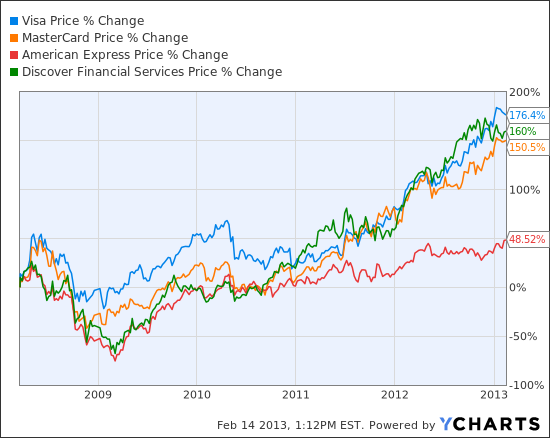The Phillips curve attached below, explains the short term inverse relationship between inflation and unemployment. However, over the longer run it suggests that the unemployment rate will pull back to its natural value if inflation rate is kept constant. But it’s not constant!

As a result of $40 billion worth of monthly liquidity injections, jobless claims recently touched their 5 year lows. But just as its effects started to wear off, Fed decided to inject $45 billion of additional monthly liquidity. This would definitely add to the country’s inflation, meaning which, the unemployment rate could continue to decline. This would further boost the disposable income in the economy which eventually presents a bullish case for credit services companies like Visa Inc (NYSE:V), MasterCard Inc (NYSE:MA), American Express Company (NYSE:AXP) and Discover Financial Services (NYSE:DFS).
The Numbers Game
But American Express and Discover Financial don’t just service retail payments. American Express is a global bank, which makes it hard for the company to deliver skyrocketing returns, similar to its other indirect peers. However Discover Financial has been able deliver similar returns, due to its relatively smaller size and series of geographical expansions. As a matter of fact, Discover Financial entered the booming Indian market, less than a year ago. The company hasn’t been involved in any mass advertising campaigns, which suggests that its growth potential in India has largely been untapped.

(comparative stock returns over the last 5 years)
The chart attached below, displays that the operating cash flows and liquid positions of Discover Financial have declined, but its liabilities have more than doubled over the last 5 years. The picture begins to look gloomy, until we add its net income to the chart. With strong net income growth, its high debt/equity ratio looks okay. Discover Financial is a growing company, and it needs capital to expand, which justifies its leveraged position.

(Key trends of Discover Financial Services (NYSE:DFS) – 5 year chart)
Reasons to Buy Visa and MasterCard
But Discover Financial also carries risks of Non-Performing-Assets or student loan defaults. Investors looking to avoid such risks should consider investing in MasterCard and Visa, even though they don’t appear to be undervalued. Both Visa Inc (NYSE:V) and MasterCard Inc (NYSE:MA) operate with little or no debt, involve less risk on transactions and their EPS is expected to grow faster than Discover Financial or American Express. Just because their P/E is above 15x doesn’t mean that the opportunity is lost.
| Company | Forward P/E | Debt/Equity | Net Profit Margin | 5yr EPS growth est. |
| American Express | 11.69x | 326% | 13.26% | 10.78% |
| Discover Financial | 8.72x | 205% | 30.64% | 10.67% |
| MasterCard | 17.17x | 0% | 37.32% | 17.83% |
| Visa | 18.19x | 0% | 22.46% | 18.57% |
For the recent quarter, Visa reported record revenues of $2.85 billion, rising 12% YoY against the estimated 10.7%. Its EPS rose by 22% due to onetime tax benefits, and its operating income stood at $2.85 billion against the estimated $2.82 billion. The street was already impressed and to add to the investors delight, the company raised its FY13 FCF guidance to $6 billion. The company already has a $1.5 billion share repurchase program, which would boost its EPS and reduce its dividend burden.
MasterCard Inc (NYSE:MA) also reported blockbuster earnings. Its quarterly revenue surged by 9.7%, and its profits surged by 18% (excluding the onetime litigation charges of $495 million) which were better than expected. The results beat the estimates. Moreover, the board of MasterCard has approved a $2 billion share repurchase program, and doubled its quarterly cash dividends.
My Foolish Conclusion
In my opinion, MasterCard and Visa are as good as an investment can get. Not only did their results crush the Street’s estimates, but their respective boards are doing everything to return value to their investors. A buyback plan when the company is doing well, only displays the amount of faith and confidence of the board in the company’s future. In my opinion the liquidity injections give investors a chance to lock in greater returns with less risk. Naturally, credit services companies, Visa and MasterCard have a better reward-to-risk ratio than their indirect peers and I think both Visa and MasterCard are worth a Buy Rating. But that doesn’t call for shorts on Discover Financial or American Express.
The article Time to Capitalize on QE3 originally appeared on Fool.com and is written by Piyush Arora.
Copyright © 1995 – 2013 The Motley Fool, LLC. All rights reserved. The Motley Fool has a disclosure policy.




